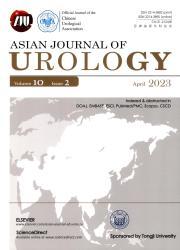A comparison between thulium fiber laser enucleation of the prostate and robot-assisted simple prostatectomy in the surgical management of large benign prostatic hyperplasia
IF 2.4
3区 医学
Q2 UROLOGY & NEPHROLOGY
引用次数: 0
Abstract
Objective
Thulium fiber laser enucleation of the prostate (ThuFLEP) and robot-assisted simple prostatectomy (RASP) are two options for treating large benign prostatic hyperplasia. The most appropriate technique remains a matter of debate. We evaluated the efficacy and safety of ThuFLEP compared to RASP.
Methods
Between January 2020 and December 2023, all patients who underwent either RASP or ThuFLEP for a prostate volume >80 mL were retrospectively included. The surgical procedure choice was left to the surgeon's and patient's discretion. Preoperative patient evaluation included the assessment of functional parameters. The groups were compared.
Results
A total of 234 patients were included: 106 (45%) underwent RASP and 128 (55%) underwent ThuFLEP. The mean operative time was shorter in the ThuFLEP group compared to the RASP group (106.4 with standard deviation [SD] 46.1 min vs. 123.2 [SD 32.8] min, p=0.012). The mean lengths of catheterization and stay were significantly longer in the RASP group (5.0 [SD 3.9] days vs. 1.7 [SD 2.0] days, p=0.009 [catheterization] and 4.9 [SD 3.0] days vs. 1.9 [SD 1.8] days, p=0.009 [stay]). The overall complication rate was significantly higher in the ThuFLEP group (12% vs. 2.8% in the RASP group, p=0.022). However, we did not observe significant differences in major complications (Clavien-Dindo ≥3) between the two groups (four [3.1%] in the ThuFLEP group vs. one [0.94%] in the RASP group, p=0.073). At 3 months, the rate of stress urinary incontinence was 4.7% after ThuFLEP and 1.9% after RASP (p=0.2). Finally, the quality of life score and maximum urinary flow were comparable between the ThuFLEP and RASP groups, but the International Prostate Symptom Score at 3 months postoperatively was lower in the RASP group (p=0.012).
Conclusion
Both ThuFLEP and RASP are safe techniques with comparable functional outcomes for large benign prostatic hyperplasia. ThuFLEP allows a reduction in catheterization and hospitalization durations but presents more complications compared to RASP.
铥纤维激光前列腺去核术与机器人辅助单纯前列腺切除术治疗大型良性前列腺增生的比较
目的铥纤维激光前列腺去核术(ThuFLEP)和机器人辅助单纯前列腺切除术(RASP)是治疗大型良性前列腺增生的两种选择。最合适的技术仍然是一个有争议的问题。我们比较了ThuFLEP与RASP的疗效和安全性。方法在2020年1月至2023年12月期间,回顾性纳入所有接受RASP或ThuFLEP检查前列腺体积80 mL的患者。手术方式的选择由外科医生和病人自行决定。术前患者评估包括功能参数评估。对两组进行比较。结果共纳入234例患者:行RASP 106例(45%),行ThuFLEP 128例(55%)。与RASP组相比,ThuFLEP组的平均手术时间更短(106.4,标准差[SD] 46.1 min vs. 123.2 [SD 32.8] min, p=0.012)。RASP组的平均置管时间和住院时间明显更长(置管时间为5.0 [SD 3.9]天比1.7 [SD 2.0]天,p=0.009;置管时间为4.9 [SD 3.0]天比1.9 [SD 1.8]天,p=0.009)。ThuFLEP组的总并发症发生率明显高于RASP组(12% vs. 2.8%, p=0.022)。然而,我们没有观察到两组在主要并发症(Clavien-Dindo≥3)方面的显著差异(ThuFLEP组有4例[3.1%],RASP组有1例[0.94%],p=0.073)。3个月时,ThuFLEP组压力性尿失禁发生率为4.7%,RASP组为1.9% (p=0.2)。最后,生活质量评分和最大尿流量在ThuFLEP组和RASP组之间具有可比性,但RASP组术后3个月的国际前列腺症状评分较低(p=0.012)。结论ThuFLEP和RASP是治疗大型良性前列腺增生的安全技术,功能效果相当。因此,与RASP相比,flep可以减少置管和住院时间,但出现更多并发症。
本文章由计算机程序翻译,如有差异,请以英文原文为准。
求助全文
约1分钟内获得全文
求助全文
来源期刊

Asian Journal of Urology
UROLOGY & NEPHROLOGY-
CiteScore
4.00
自引率
3.80%
发文量
100
审稿时长
4 weeks
期刊介绍:
Asian Journal of Urology (AJUR), launched in October 2014, is an international peer-reviewed Open Access journal jointly founded by Shanghai Association for Science and Technology (SAST) and Second Military Medical University (SMMU). AJUR aims to build a communication platform for international researchers to effectively share scholarly achievements. It focuses on all specialties of urology both scientifically and clinically, with article types widely covering editorials, opinions, perspectives, reviews and mini-reviews, original articles, cases reports, rapid communications, and letters, etc. Fields of particular interest to the journal including, but not limited to: • Surgical oncology • Endourology • Calculi • Female urology • Erectile dysfunction • Infertility • Pediatric urology • Renal transplantation • Reconstructive surgery • Radiology • Pathology • Neurourology.
 求助内容:
求助内容: 应助结果提醒方式:
应助结果提醒方式:


